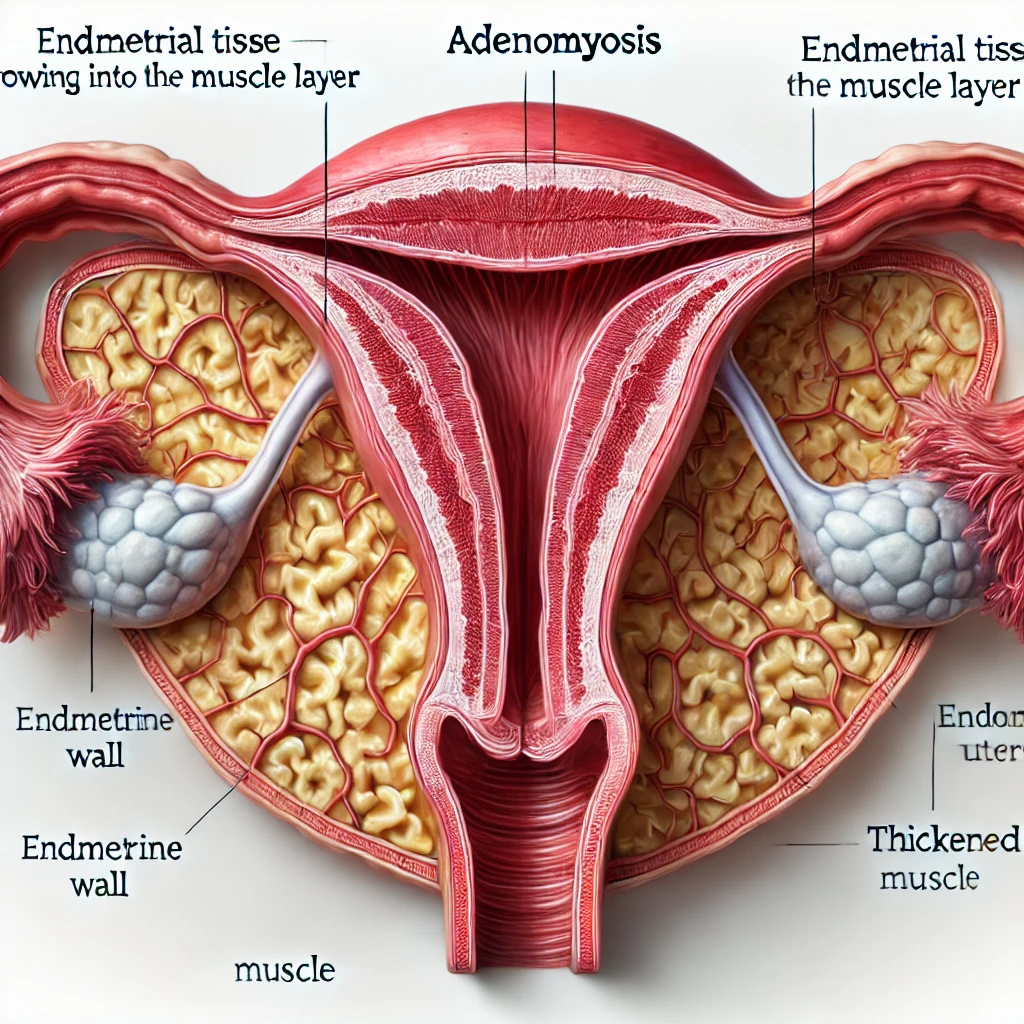
Introduction
Adenomyosis is a gynecological condition in which the endometrial tissue, which normally lines the uterus, grows into the muscular wall of the uterus. This leads to the thickening of the uterine walls, causing symptoms like heavy menstrual bleeding, severe cramps, and an enlarged uterus.
It primarily affects women in their 30s and 40s, especially those who have had children. While it is a benign (non-cancerous) condition, it can significantly impact a woman’s quality of life.
What is Adenomyosis?
Adenomyosis occurs when endometrial cells infiltrate the myometrium (the muscular layer of the uterus). This abnormal growth can lead to inflammation, thickening, and painful symptoms.
Types of Adenomyosis:
- Diffuse Adenomyosis:
- Spread throughout the uterine wall.
- Focal Adenomyosis (Adenomyoma):
- Localized to one area, forming a mass-like lesion.
Symptoms of Adenomyosis
The severity of symptoms can vary from mild to debilitating.
Common Symptoms:
- Heavy Menstrual Bleeding
- Prolonged or abnormally heavy periods.
- Severe Menstrual Cramps (Dysmenorrhea)
- Intense pain during menstruation.
- Pelvic Pain
- Chronic pain not limited to menstruation.
- Enlarged Uterus
- The uterus may become tender and feel bulky.
- Painful Intercourse (Dyspareunia)
- Discomfort during or after sexual activity.
- Spotting Between Periods
- Unexplained bleeding outside the menstrual cycle.
Causes of Adenomyosis
The exact cause of adenomyosis is not fully understood, but several theories and risk factors have been identified.
Potential Causes:
- Invasive Tissue Growth
- Endometrial cells invade the uterine muscle.
- Hormonal Factors
- Estrogen and progesterone may promote the condition.
- Childbirth Trauma
- Uterine inflammation or damage during delivery may trigger adenomyosis.
- Stem Cell Theory
- Abnormal differentiation of stem cells in the uterine muscle.
Risk Factors:
- Age: Common in women aged 30–50.
- Parity: More likely in women who have given birth.
- Previous Uterine Surgery: Such as cesarean section or fibroid removal.
- Hormonal Imbalance: High levels of estrogen may contribute to the condition.
Diagnosis of Adenomyosis
Diagnosis often involves a combination of clinical evaluation and imaging studies.
Diagnostic Methods:
- Medical History and Physical Exam
- Assessment of symptoms and uterine enlargement.
- Ultrasound
- May reveal thickened uterine walls.
- Magnetic Resonance Imaging (MRI)
- Provides detailed images to confirm adenomyosis.
- Endometrial Biopsy
- Rarely needed but may rule out other conditions.
Treatment for Adenomyosis
Treatment depends on the severity of symptoms, the patient’s age, and whether she plans to have children.
Non-Surgical Treatments:
- Medications:
- Hormonal Therapy: Birth control pills, intrauterine devices (IUDs) with progestin, or gonadotropin-releasing hormone (GnRH) agonists.
- Anti-Inflammatory Drugs: NSAIDs to manage pain and inflammation.
- Lifestyle Changes:
- Regular exercise and a balanced diet to manage symptoms.
Minimally Invasive Procedures:
- Uterine Artery Embolization (UAE):
- Reduces blood flow to the uterus, shrinking adenomyosis.
- Endometrial Ablation:
- Removes the uterine lining to reduce heavy bleeding.
Surgical Treatment:
- Hysterectomy:
- Complete removal of the uterus.
- Considered the definitive treatment for severe cases when other methods fail.
Complications of Adenomyosis
If left untreated, adenomyosis can lead to complications, such as:
- Severe Anemia: Due to heavy menstrual bleeding.
- Chronic Pain: Pelvic discomfort can disrupt daily activities.
- Infertility: Although rare, adenomyosis may impact fertility in some women.
Prevention of Adenomyosis
While there’s no guaranteed way to prevent adenomyosis, the following steps may reduce the risk:
- Regular Check-Ups:
- Early detection through routine gynecological exams.
- Manage Hormonal Balance:
- Use medications as prescribed by your doctor.
- Limit Uterine Trauma:
- Avoid unnecessary uterine surgeries when possible.
Frequently Asked Questions (FAQ)
Q: Is adenomyosis the same as endometriosis?
A: No, while both conditions involve the endometrial tissue, adenomyosis affects the uterine wall, whereas endometriosis occurs outside the uterus.
Q: Can adenomyosis affect fertility?
A: In some cases, it may impact fertility, but many women with adenomyosis can still conceive with proper management.
Q: Will adenomyosis go away after menopause?
A: Symptoms often improve or resolve after menopause when hormone levels naturally decline.
Q: Is surgery always necessary for adenomyosis?
A: No, many women manage symptoms with medication or minimally invasive procedures. Surgery is typically a last resort.
Takeaway
Adenomyosis is a common but often underdiagnosed condition that can significantly affect women’s health. Early diagnosis and individualized treatment plans can help alleviate symptoms and improve quality of life.
If you suspect adenomyosis, consult a gynecologist to discuss your symptoms and explore the best treatment options.
Read more Acute Intermittent Porphyria: Symptoms, Diagnosis, and Treatment
Leave a Reply